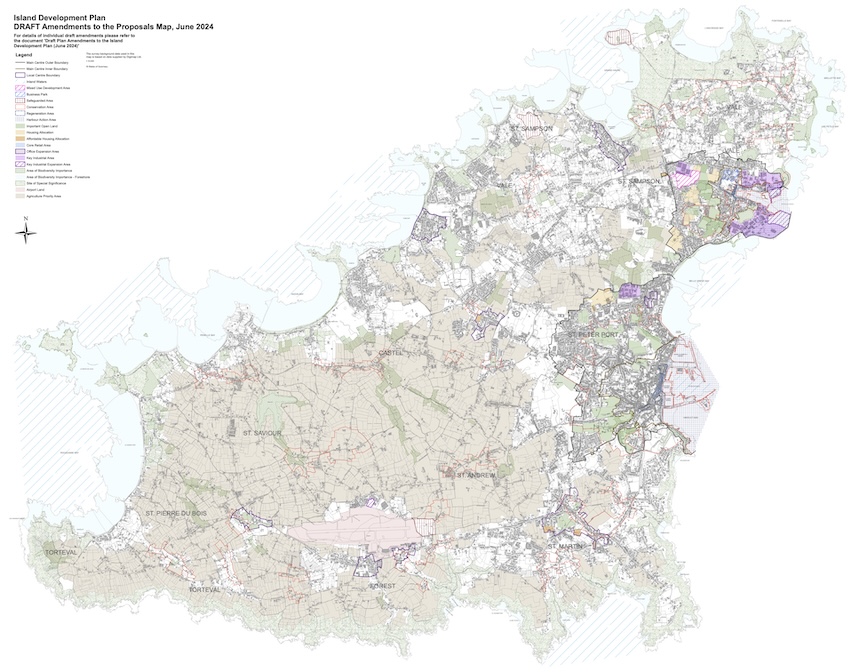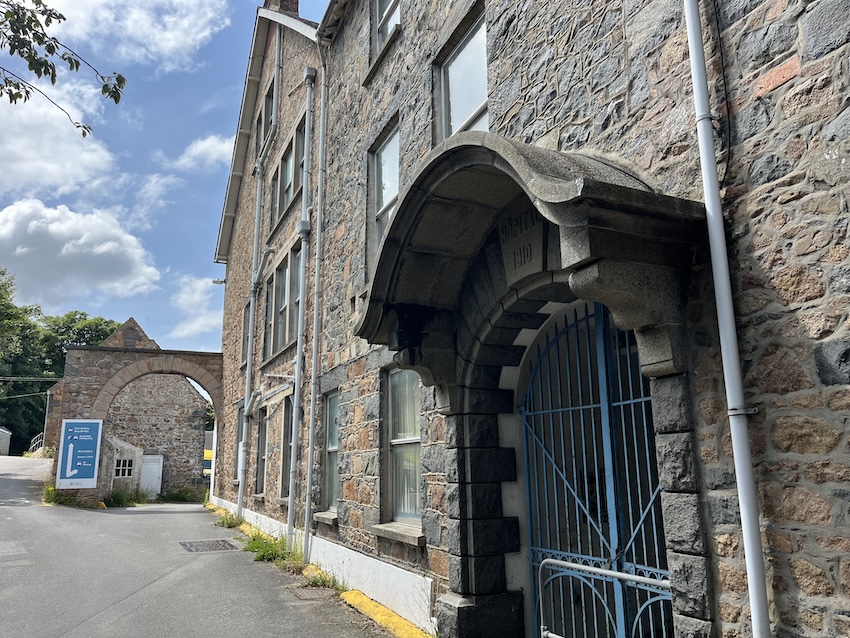


An inflated housing goal which has been questioned by independent experts has combined with States inertia on brownfield sites to leave fields under threat of development.
Analysis of the draft Island Development Plan by Express shows that fields in the Castel and St Martins would not need to be zoned for affordable housing but for a decision by the Development & Planning Authority to add a large buffer to the indicator for affordable housing that goes beyond what would normally be expected.
Neighbours are furious that fields which have been used for grazing and growing for years are being targeted for housing when they also know the States is sitting on large brownfield sites like Castel Hospital.
They also see more suitable derelict greenhouse sites ruled out because of States policies.
Consultation is still open on the draft IDP, but people have been faced with complicated forms which some have argued put them off making a submission as well as wading through reams of planning policies and supplementary reports to try and get to the heart of the decision making.
In an online Q&A last week, Development & Planning Authority President Deputy Victoria Oliver referenced their decision to add a “buffer” of 15% to the strategic housing indicator for how much private housing there should be in the five year period covered by the IDP and of 25% for affordable housing.
You need to dive into some supplementary reports to try to unravel the DPA’s thinking here.
“The extra contingency at this stage is… in recognition that there are indications that population trends are likely to be higher than the forecast used in the current SSHI model,” it said in its strategic housing land availability assessment.
The housing indicator was partially based on the States agreement in 2022 that net migration will average up to plus 300 annually over the next 30 years.
The figure fluctuates. In the year ending June 2023 the population had grown by 645 people, the year before that by 412, before that by 511 and in 2020 it fell by two.
This is all crucial because the number of homes DPA decides is needed dictates how much land is zoned for housing - everyone should be interested in trends, not one off years.
The affordable housing goal is even more subjective and inflated than the private sector, with the buffer 10% higher.
“The additional 10% allowance for Affordable Housing is to provide flexibility for the States and housing associations, and to allow for the likely, but as yet unquantified, need for land for Key Worker housing and / or specialised housing, and given that privately owned sites may not be being brought forward for development.”
Partly this is a consequence of the States dropping the affordable housing requirement from large private developments because it was seen as a block, but the reference to “unquantified needs” will be seized on by campaigners.
By adding 25% to the affordable housing indicator, all of a sudden 901 houses need to be catered for rather than 721.

Pictured: A map showing proposed changes to the IDP.
The DPA’s assessment of available sites within existing main or local centres shows there is enough land for 735 affordable housing units. Primarily this is the Saltpans taking 473 houses, Belgrave Vinery 148 and La Vrangue 91.
So it is only by adding 25% that other areas have to come into play and it led to earmarking sites beyond the current boundaries of where development is expected to be concentrated.
They include a field adjacent to the current L’Aumone centre, another at Ville Amphrey outside the St Martins centre.
Pictured: Le Tassin on the edge of the L'Aumone centre will be zoned for affordable housing under DPA's draft plan.
In the documentation available online is a peer review by planning and development consultancy Lichfields.
It was appointed by DPA in June 2023 to check the methodology behind its figures.
Lichfields said that it is inevitable sites identified will be delayed or not come forward for various reasons, therefore a buffer was considered appropriate.
“In Guernsey, this is a matter for the States to decide; as the States has applied a housing indicator rather than a housing target it may not be strictly necessary to apply a buffer,” it said.
“However, we note that a 10% buffer is included in the indicator itself, to respond to market changes. Including a 10% buffer would therefore be consistent with this approach.”
The States itself is sitting on sites that could be used for up to 663 dwellings, but they have not been included because they are not seen as being available in the next five years.
There has been a long history of the States struggling to free up sites, often leaving staff working in unsuitable conditions too.

Pictured: Castel Hospital.
The Castel Hospital site has been the focus of much attention this term as one of those that could contribute significantly to the housing targets, but because it is not included in the figures leaves other green fields moving ahead of it in the pecking order
Ultimately progress has been slow on Castel, even if the DPA is now looking to redraw the L’Aumone centre boundary to include it and so reduce the number of planning hurdles it faces in the future.

The consequence of States inertia over freeing up this site, of past decisions to direct development in built up areas and of the “buffers” in the housing goals can be best illustrated when you walk through the nearby lane in Ruette de la Croix and imagine what it might look like in a few years time.
This 0.68 hectare field has for the last few decades been used for grazing and growing, but neighbours said that stopped this season for the first time. It is bordered by mature trees, bird song rings out and the views from the lane over to the other islands are stunning.
It’s categorised as “best and most versatile land”.
Driving past on the main road it is easy to miss, although right now the protest signs help draw attention to its plight. If DPA’s ideas come to fruition there will be 35 houses built on it, with access leading out onto the busy Route de Cobo.
Pictured: Signs draw attention to the potential plight of this field in the Castel.
In St Martins there is a similar situation where 0.38 hectare arable field in Ville Amphrey will be zoned for affordable housing. 24 houses could be built here, 80% of them expected to be affordable.
Another field in La Vrangue would be swept into a development zone under DPA’s proposals.
Many would prefer to see derelict vinery sites targeted before these open fields, a point raised during a recent online DPA Q&A.
DPA President Deputy Victoria Oliver said: ”We’ve looked at it to make sure there is enough land for the next five years. Those sites have to be adjacent or right next to the main centres, so that's why you are quite sort of constrained as to where you can put these houses. They can't just be pepper potted around the island where all the greenhouses are. They have to be in strategic locations, which many might find frustrating, but that’s where they have to go because that’s the plan the States had 11 years ago.”

Pictured: How development has been concentrated since 2011.
She was referring to the Strategic Land Use Plan, which was designed to last until 2031.
Its policies are what the IDP has to deliver, but with discussion raging about a housing crisis some are talking about whether SLUP is now fit for purpose.
“We have 460.7 vergees (2019 figure) of redundant glass across the island on sites that will never again be used for growing but most are ruled out of consideration by the SLUP,” said Deputy Steve Falla recently.
"The States has spent this political term wringing its hands over the housing crisis when what we probably should have been doing was looking at whether the SLUP could or should be reviewed as an exceptional approach to address exceptional circumstances."
Building on a open field will be easier than moving staff out of a rundown States property like Castel Hospital and negotiating the planning hurdles that listing part of the existing property has created.
Progress on other large housing sites behind the Bridge has also stalled because the States has failed to deliver on flood prevention. Reports recommending action on flood prevention date back to 2012.
Failure to build enough homes to meet the island’s needs is not solely down to the Island Development Plan, there are a myriad of factors at play.
Capacity within the industry, the cost of building material, the availability of finance, they are all feeding into what some have dubbed a housing crisis.
You can now throw into the mix the same board members of the Development & Planning Authority that are behind the draft IDP deciding to throw out a proposal to create a temporary stockpile of inert waste, think builder’s waste here, that planners had backed, even as the current storage nears capacity.
The fear will be that in the rush to solve this housing problem, unnecessary damage is caused along the way.
The draft IDP is open for comments until Monday.
Visit https://gov.gg/IDP-review for all the documentation.
Comments
Comments on this story express the views of the commentator only, not Bailiwick Publishing. We are unable to guarantee the accuracy of any of those comments.